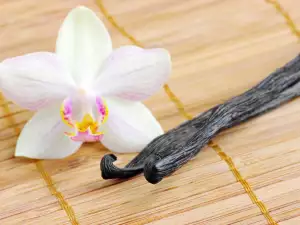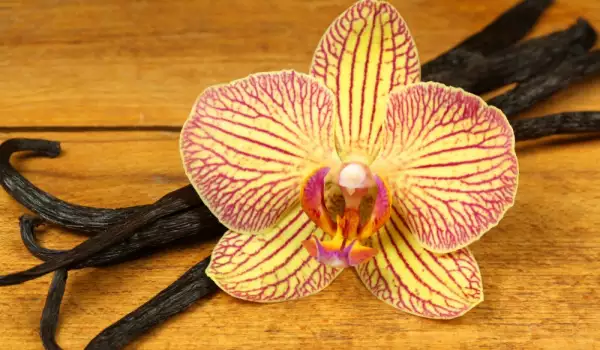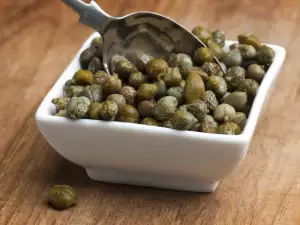Thanks to its gentle, refreshing flavor, vanilla is considered one of the most subtle and pleasant spices. Vanilla as a spice often gets used in the confectionery industry and its scent is suitable for creams, ice cream, cookies, candy, etc. Vanilla gives a special and sophisticated flavor liqueurs and cigarillos. The noble aroma of the vanilla plant comes from the orchid family, it is the only plant of this kind that is used in cooking.
Vanilla is a tropical orchid, having a moving, green, long, fleshy stem with multiple branches grasping for the stem of the tree, just like other parasitic plants. The flowers are yellow to orange and grow in clusters. On a single day, only one flower blooms. The flowering period is two months long.
History of Vanilla
Vanilla gathered laurels and fame since ancient times, it was best known for being a sexual stimulant.
The Aztecs used vanilla for the preparation of their royal drink xocolatl - a mixture of cocoa beans, vanilla and honey, considered a powerful aphrodisiac. The very name vanilla comes from the Spanish word for a vagina, or a pod. The birthplace of vanilla is believed to be Mexico, Panama and the West Indies. In Europe, it only became known in the 16th century after the conquistador Hernan Cortes entered the Aztec capital. Emperor Montezuma offered the white man, as a sign of peace and good faith, their ritual drink made precisely from chocolate, flavored with vanilla. Then Europeans carried vanilla to other tropical areas, but unfortunately did not manage to get fruit at any point.

Finally, in 1836, the Belgian botanist Charles Morren found that the colors of vanilla is not pollinated, but human intervention is needed. In 1841, on the French island of Réunion, Edmond Albius perfected the artificial development method used today. Hand pollination of vanilla and additional manual processing and fermentation identify the high price of this spice. Vanilla starts to bear fruit in the third year after planting and does so for 35-40 years.
The first, to add vanilla in their meals, were the cooks at the court of Queen Elizabeth the First.
Growing vanilla
In essence, vanilla is a perennial vine. It is attached to trees, and wraps around them as it grows, rising up to their crown. Vanilla has large white or greenish flowers. It blooms only once a year and pollinates through small insects such as Melipona- a sort of hummingbird that lives only in Mexico. Because their monopoly in growing, Mexican vanilla has long been dominant. Today, vanilla is grown on the island of Madagascar, the Caribbean and Sri Lanka. The process used is artificial pollination.
Vanilla fruits are also considered usable. Its pods are 15-25 cm long and 4-8 cm wide. It is important to break them still unripe, so as not to splinter. The process requires vanilla flowers to be put in hot water for 20 minutes, then wrapped in woolen blankets at about 60 °C. Finally, the fruits of the vanilla are dried in the sun for 1.5 - 2 months. A curious fact is that to buy a shirt that costs 05.07 dollars a person in Madagascar has to produce 10 kg vanilla.
As a product, vanilla is typically used powdered or ground and mixed with sugar at a ratio of 1 to 0.5 kg of sugar. The chemical composition in the fruits of vanilla is about 3% vanilocide that fermentation provides vaniol and vanillin, piperonal and even some aromatic substances in very small quantities - aniseed essential oil, cinnamon oil and other substances.

Application of vanilla
The artificial substitute for vanilla called vanillin. It is less aromatic, because natural vanilla vanillin also contains many other natural aromatic components. Vanilla is produced by filtration through alcohol and water broken grains, like in the coffee industry. Vanilla is very strong. It is used in the preparation of desserts, creams and ice cream. If you add a little vanilla in icing sugar, you will get very fragrant powdered sugar, suitable for a variety of cakes and sweets.
Vanilla finds a great application and outside cooking, it is a raw material in the manufacture of perfumes. Europeans prefer to use seeds, while in North America- the essence is valued more. Best for vanilla is to keep it in an airtight container. Tricks for storing show that they last the longest and stay full, when buried in sugar. Thus, flavored sugar can be used after two to three weeks for tampering with coffee or tea.
Improve the taste of the milk with vanilla on the tip of a knife. Add a little vanilla to black tea and it will have a very interesting aroma and taste.
Benefits of vanilla
Many people, mostly women, are accustomed to the idea that stress is removed with something sweet and eat something sweet every time they are nervous. The scent of vanilla produces a joyful feeling and a feeling of fullness. Vanilla is very useful for women, as it helps to relieve symptoms during their cycle. The main benefit of vanilla is its calming effect. It can improve your mood and raise your spirits.
The sweet scent of vanilla creates a relaxing effect, removes nervous tension, puts out negative thoughts and awakens creativity, intuition and optimism. Aromatic acid, a major component of vanilla essential oil has a beneficial effect on the skin. For muscle pain and tension, vanilla extract essential oil can be used. Vanilla extract improves digestion, suppress pain, relaxes, reduces inflammation and protects against infection.
If you had a bad day and in the evening you are at an important meeting, use vanilla oil and everything will be fine. Scented lamps with a few drops of vanilla or a vanilla candle will soothe even disobedient children.
In the 18th century, vanilla gained popularity as a powerful aphrodisiac. Bath oil with vanilla evokes sensuality and is ideally suited to remind loved ones that romance should not be forgotten. Mix half a cup of liquid cream with a drop of rose oil and three drops of vanilla. Pour the mixture into the tub and mix well.





















